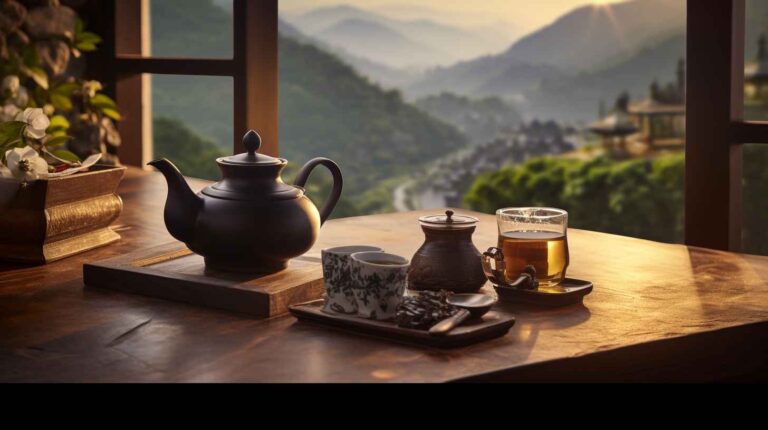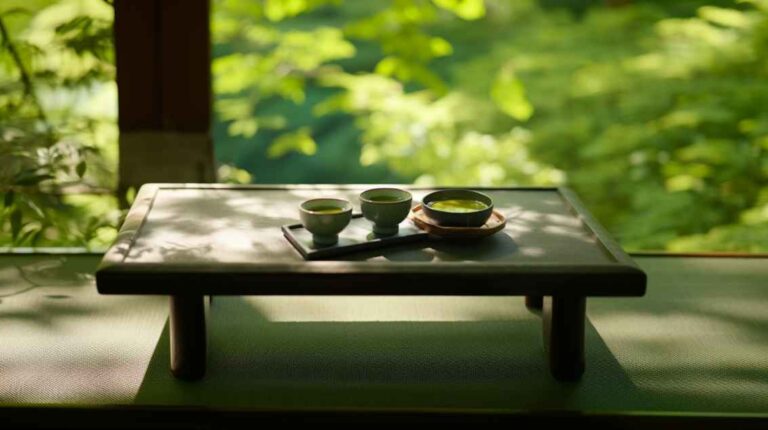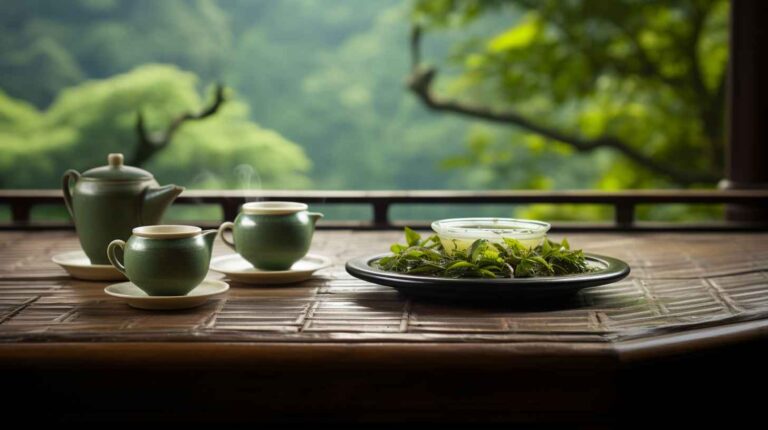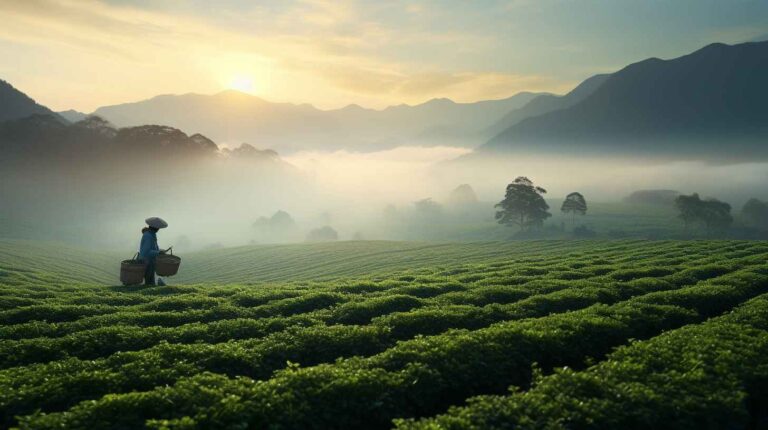Journey to the Green: Discovering the World of Green Teas
Introduction
Tea, the world’s second-most consumed beverage after water, is a potent connector of cultures, a catalyst of revolutions, and a solace provider to countless souls. While the broad umbrella of tea encompasses various types, there’s a unique allure to green tea. This particular variant distinguishes itself not just with its subtle, earthy flavors, but through its intricate weave with history, culture, and health. As we trace green tea’s footsteps, from the pristine slopes of China to the vibrant streets of Tokyo, we discover a narrative as layered as the tea’s own tasting notes.
The Historical Tapestry of Green Tea
The history of green tea is both fascinating and mythical. The serendipitous discovery of green tea can be traced back to ancient China, particularly to an enchanting tale from 2737 BCE. Legends speak of Emperor Shen Nong’s fortuitous find. As the story goes, while he rested beneath a tree, a whimsical breeze tossed a few leaves into his boiling water pot. This simple act of nature unveiled the first-ever brew of green tea, a drink that soon transcended its accidental origins to become the centerpiece of a cultural revolution.
As centuries rolled on, each Chinese dynasty left its unique fingerprint on tea’s evolution. The Tang Dynasty (618-907), in particular, transformed tea drinking into an art form. It was during these times that seminal literature, such as Lu Yu’s “The Classic of Tea,” emerged. This text was more than just a guide; it was a philosophical meditation on tea’s spiritual and health dimensions. Its verses captured the essence of tea, linking its spirit to societal ethos. The following Song Dynasty further elevated tea’s stature, with tea ceremonies taking center stage in social engagements. Halls echoed with the profound discussions of poets and scholars, as they mused over the secrets of a perfect brew.
By the Ming Dynasty, green tea was not just a beverage; it was an integral thread in China’s cultural fabric. Expansive trade routes now carried its legacy, weaving its story from the sun-drenched deserts of Central Asia to the icy embrace of the Himalayan peaks.
Regions and Their Signature Brews
Green tea is a vast universe in itself. Its spectrum is expansive, and each regional variant is a window into its native culture:
- Dragon Well (Longjing): The placid West Lake in Hangzhou, China, offers the world the gift of Dragon Well. Unique in its flattened leaf appearance, this tea undergoes a meticulous pan-roasting technique. The result? A captivating toasted and nutty aroma that distinguishes it from other varieties.
- Sencha: This is Japan’s cherished contribution to the green tea lineage. A specialized steaming process ensures that Sencha leaves shimmer in a vibrant green shade. Its taste paints a dynamic picture – a hint of grassy freshness followed by a profound umami undertone.
- Matcha: Matcha defies the traditional norms of tea consumption. Instead of discarding the leaves post-brew, Matcha celebrates the whole leaf, ground to a fine powder. This lends the tea a lush, velvety texture and a potent flavor, making it a cornerstone of Japanese tea ceremonies and a staple in contemporary lattes.
- Biluochun: Nestled in the scenic mountains of Jiangsu, China, Biluochun is a visual and sensory delight. Its spiraled leaves perform a mesmerizing ballet in the brew, releasing an aroma that conjures images of blooming orchards, complemented by a delicate fruity hint.
- Gyokuro: Often hailed as the crown jewel of Japanese teas, Gyokuro’s unique shaded cultivation intensifies its green vibrancy. The resultant brew is an exquisite melding of sweetness and rich umami.
More Than A Beverage: Green Tea’s Health Proposition
Green tea’s reputation isn’t limited to its refreshing taste; it’s also renowned for its myriad health benefits, many of which have been revered for centuries and are now being affirmed by modern science:
- Oxidative Stress Combatant: Abundant in catechins, green tea is a formidable antioxidant powerhouse. These dynamic compounds are our body’s allies, relentlessly battling against free radicals. The result? A shield against oxidative stress that could culminate in premature aging and various ailments.
- Cognitive Enhancer: Think of a sip of green tea as a gentle cognitive caress. It boasts a unique blend of L-theanine and caffeine, a combination that bestows heightened alertness without inducing restlessness. This harmony enhances mental faculties like focus, memory, and even uplifts mood.
- Heart’s Guardian: In an era where cardiovascular diseases cast a lengthy shadow, green tea emerges as a beacon of hope. Its potential lies in its ability to lower LDL cholesterol, making it a prime choice for heart health.
- Metabolic Booster: For many embarking on the challenging path of weight loss, green tea could be a trusted companion. Scientific studies have linked green tea’s compounds to enhanced metabolism and escalated fat oxidation, making it a potential ally in weight management endeavors.
- Cancer Defense: The fight against cancer is intricate, and while research is still in its formative stages, preliminary findings are promising. Green tea’s rich phytonutrients appear to have properties that could potentially inhibit cancer cell growth.
Green Tea in Contemporary Culture
In an era marked by rapid advancements and swift societal transitions, green tea remains a reassuring constant, its roots entrenched in age-old traditions. Yet, its resilience isn’t born from resistance to change but from its adaptability. While it carries the weight of millennia-old history, green tea also seamlessly melds into the ever-evolving narrative of modern culture. Whether it’s the traditional brewing method that invokes ancestral memories or the fresh innovations that align with contemporary lifestyles, green tea continues to be relevant, versatile, and timeless.
Bridging the Old with the New
The culinary realm stands as a testament to green tea’s adaptability. No longer limited to teapots and cups, green tea’s essence now infuses an array of gastronomical delights:
- Matcha Lattes: With the dawn of each day, millions find solace in the warm embrace of Matcha lattes. This modern spin on a traditional beverage offers a creamy texture, the rich taste of Matcha, and a caffeine kick to start the day.
- Green Tea Desserts: World-renowned patisseries and local bakeries alike have found a muse in green tea. Desserts like green tea tiramisu or Matcha ice cream provide a perfect balance of sweetness and the characteristic bitter notes of the tea.
- Cocktail Innovations: The spirited world of mixology hasn’t remained untouched by the green wave. Modern mixologists artfully craft drinks like Matcha Mojitos and Green Tea Martinis, merging the ancient with the avant-garde, and the subtle with the spirited.
However, green tea’s modern renaissance isn’t just confined to edibles and drinkables. The burgeoning health and wellness industry, with its emphasis on organic and natural remedies, finds an ally in green tea.
Beyond The Cup: Green Tea’s Multifaceted Avatars
The embrace of green tea extends far beyond the confines of a cup. Its reach can be witnessed across diverse industries, each celebrating its unique attributes:
- Skincare Revolution: The beauty industry has been smitten by green tea’s allure. Its potent catechins, renowned for combating free radicals, have become a sought-after ingredient. Whether it’s face masks promising revitalized skin or cleansers ensuring a deep cleanse without stripping natural oils, green tea’s benefits are being harnessed widely.
- Haircare Elixirs: The world of haircare too is witnessing a green tea revolution. Shampoos infused with green tea extract pledge not just cleanliness but also protection from environmental aggressors and potential hair loss prevention.
- Wellness & Spa: The essence of relaxation now carries a hint of green. Many spa treatments, recognizing green tea’s detoxifying properties, offer therapies like green tea baths or exfoliating scrubs, ensuring rejuvenation of both mind and body.
- Fragrance Industry: The realm of fragrances, always on the lookout for fresh and invigorating scents, finds a match in green tea. Perfumes and colognes infused with green tea notes promise a scent that’s both calming and energizing, perfect for the modern individual.
Production and Processing: A Symphony of Nature and Craft
The journey of green tea, from a verdant leaf on a bush to a soul-soothing brew, is poetic. It’s a dance between nature’s bounty and human craftsmanship.
The First Steps: Harvesting and Initial Processing
Every great story starts with a deliberate choice, and so does the story of each green tea leaf. Amidst vast plantations, skilled pickers, with years of experience, handpick only the youngest and finest leaves. This deliberate selection lays the foundation for the tea’s eventual aroma and flavor.
Regional nuances play a significant role in the subsequent steps. While Japanese tea artisans might opt for steaming, imparting the tea with a verdant hue and fresh taste, their Chinese counterparts often prefer pan-frying, lending a toastier note to the brew.
Shaping, Rolling, and Drying: Crafting The Final Leaf
The artistry continues as the leaves undergo rolling. This process, be it manual or mechanical, is vital. It’s here that the leaf gets its signature shape – a shape that also influences its eventual flavor, given the alterations to its cellular structure. The final act in this intricate ballet is drying, where gentle heat preserves the tea’s inherent flavors, preparing it for its journey to tea enthusiasts worldwide.
Conclusion
Green tea stands as an ode to the harmonious collaboration between nature and human endeavor. It celebrates the magic that can transpire when a simple leaf, treated with reverence and skill, evolves into a drink that resonates across borders, cultures, and epochs. The saga of green tea, from ancient rituals to groundbreaking modern innovations, mirrors our own human journey – a journey marked by a continual search for authenticity, wellness, and unparalleled taste. As we cradle our cups of green tea, we are not merely savoring a beverage; we are partaking in a legacy – a legacy that has been meticulously crafted over centuries and promises to endure for many more to come. Every sip is not just refreshment; it’s a tribute to history, tradition, and ceaseless innovation. And as the narrative of green tea continues to unfold, its place as a timeless elixir remains unchallenged.






